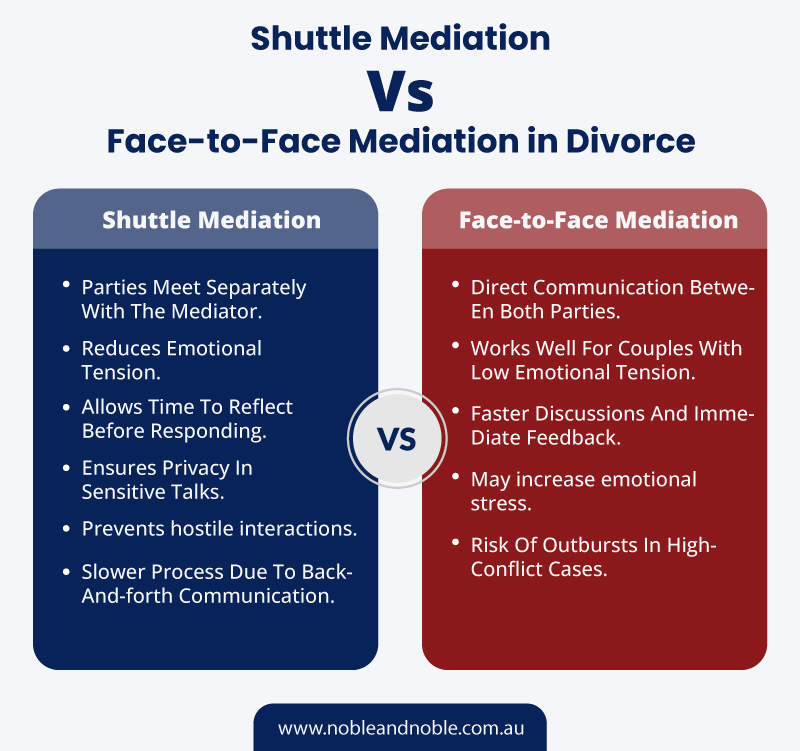
Exploring the Shuttle Mediation Pros and Cons in Family Law
Mediation has become one of the most popular methods for resolving disputes in family law, providing a more amicable and cost-effective alternative to court proceedings. Among the various types of mediation, shuttle mediation has emerged as a powerful tool, particularly in cases where direct communication between parties is either not feasible or not advisable. But is shuttle mediation the right approach for every family dispute? This article will explore the shuttle mediation pros and cons in family law, offering insights into its suitability for different family law situations.
Table of Contents
What is Shuttle Mediation?
Shuttle mediation is a form of alternative dispute resolution (ADR) where the disputing parties do not sit in the same room. Instead, the mediator acts as a go-between, moving (or “shuttling”) between the parties to facilitate communication and negotiation. This process is often used in family law cases that are high in conflict, such as divorces or custody disputes, where direct communication could escalate tensions.
In contrast to traditional mediation, where parties are encouraged to communicate face-to-face, shuttle mediation offers a safer and less confrontational environment. By separating the parties, the mediator can manage emotions, ensure privacy, and promote a fair negotiation process. This method is frequently applied in family disputes where emotions run high, or in cases of domestic violence where direct interaction would be inappropriate.
The Rise of Shuttle Mediation in Family Law
In recent years, shuttle mediation has become more prevalent as family law cases have grown more complex and emotionally charged. Courts and legal professionals have increasingly recommended shuttle mediation as a preferred method for resolving sensitive disputes without escalating conflicts further.
One of the driving factors behind this rise is the adaptability of shuttle mediation to high-conflict family situations. Whether it’s a bitter divorce or a protracted child custody battle, shuttle mediation allows for a calm, structured approach, offering a middle ground where the focus can remain on resolving the dispute, not on winning a personal battle.
Shuttle Mediation vs. Face-to-Face Mediation in Divorce

Face-to-Face Mediation:
- Both parties are in the same room and engage in direct communication.
- Works well for couples who can communicate openly without significant emotional strain.
- Allows for quicker discussions and real-time feedback.
- May increase emotional tension for some couples.
- Can lead to outbursts or hostility in high-conflict divorces.
Shuttle Mediation:
- The mediator meets with each party separately, avoiding direct confrontation.
- Reduces immediate emotional tension by keeping parties apart.
- Allows individuals time to reflect before responding, promoting more thoughtful communication.
- Ensures privacy for sensitive discussions, as information is shared individually.
- Helps prevent hostile interactions that might derail the process in high-conflict cases.
- Can slow the process, as the mediator relays messages between the parties.
The Role of the Mediator in Shuttle Mediation
The mediator’s role in shuttle mediation is critical. Unlike traditional mediation, where the mediator facilitates a conversation between the parties, in shuttle mediation, the mediator must act as a skilled intermediary. They shuttle between the two parties, accurately relaying messages, proposals, and counteroffers, while ensuring that the integrity of the negotiation process is maintained.
This approach requires the mediator to be:
- Neutral: Ensuring that they do not favour one party over the other.
- Patient: Given the back-and-forth nature of shuttle mediation, the process can take longer. The mediator must be skilled at managing time effectively.
- Clear Communicator: Mediators must be adept at translating the emotions and intentions behind the words of each party to avoid misunderstandings.
Privacy and Confidentiality in Shuttle Mediation
One of the standout advantages of shuttle mediation is the level of privacy and confidentiality it offers. Unlike traditional mediation, where sensitive topics may be discussed openly in front of the other party, shuttle mediation allows each side to have private discussions with the mediator. This is particularly useful in family law cases involving financial disclosures, domestic violence, or sensitive custody issues.
Confidentiality is paramount in family disputes, especially when protecting the interests of children. By maintaining separate discussions, shuttle mediation ensures that each party’s concerns can be addressed without the fear of being overheard or judged by the other side.
Shuttle Mediation in Domestic Violence and Abuse Cases
One of the primary reasons for using shuttle mediation in family law is its effectiveness in cases involving domestic violence or abuse. In these situations, direct communication between the parties can be unsafe, and forcing an abused party to face their abuser can be traumatic.
In such cases, shuttle mediation provides a safe, structured environment where the victim can communicate their needs and concerns without fear of intimidation or manipulation. The mediator ensures that the victim’s voice is heard while maintaining the necessary distance to protect their safety and emotional wellbeing.
Shuttle Mediation: A Faster Solution?
While shuttle mediation offers many benefits, it is not always a faster solution. In fact, one of the key drawbacks is that the process can take longer than traditional mediation. Since the mediator must meet with each party separately and relay information back and forth, shuttle mediation can be more time-consuming.
However, in high-conflict cases, this extra time can be beneficial. It allows parties to cool off between sessions and consider their responses carefully, leading to more thoughtful decisions that are likely to have lasting results.
Shuttle Mediation Pros

Benefits of Shuttle Mediation for Families
Shuttle mediation offers several key benefits, particularly for families navigating sensitive issues like divorce, child custody, and financial disputes. The following advantages make it a popular choice in many family law cases:
- Emotional Safety: By keeping the disputing parties apart, shuttle mediation reduces the emotional intensity that can occur during face-to-face negotiations. This is especially beneficial in situations where one party may feel intimidated or uncomfortable interacting directly with the other.
- Better Control of Communication: The mediator can carefully frame messages to ensure that misunderstandings are minimised, and parties have time to consider their positions before responding. This measured approach allows for more thoughtful negotiation.
- Focus on Resolution: In many cases, direct communication can lead to emotional arguments that sidetrack the mediation. In shuttle mediation, the focus remains on the issues at hand, and the mediator can keep discussions more productive.
- Privacy and Confidentiality: Shuttle mediation provides a higher level of privacy since each party communicates separately with the mediator. This can be particularly helpful when discussing sensitive financial matters or personal issues.
How Shuttle Mediation Protects Children in Custody Disputes?
In child custody disputes, the welfare of the children is often the most critical issue. Shuttle mediation can play a pivotal role in protecting children from the emotional fallout of their parents’ conflict. By keeping the parents separated, shuttle mediation reduces the chances of heated exchanges that could negatively affect the children.
Moreover, the mediator can help parents focus on what’s truly important: the best interests of the child. Without the distraction of personal grievances, shuttle mediation enables parents to make decisions that prioritise the child’s needs, whether it’s regarding living arrangements, schooling, or visitation schedules.
Cost-Benefits of Shuttle Mediation for Families
Despite potentially longer sessions, shuttle mediation can still be a cost-effective option for families. By avoiding lengthy court battles, which can be incredibly expensive, families can resolve their disputes in a less formal, more affordable setting.
In cases where court proceedings are likely to drag on, shuttle mediation offers a more streamlined, financially viable solution. The structured nature of mediation often results in fewer delays, meaning that the overall cost can still be lower than litigation, even with the added time.
Cons of Shuttle Mediation: Can It Prolong Disputes?
While there are many advantages to shuttle mediation, it’s not without its drawbacks. One of the most significant disadvantages is the potential for the process to take longer than traditional face-to-face mediation. The back-and-forth nature of the process can slow things down, leading to frustration for parties who are eager to reach a resolution quickly.
Additionally, some critics argue that the lack of direct communication can impede understanding between the parties. Without the opportunity to speak face-to-face, parties may feel disconnected from the negotiation process, which could lead to dissatisfaction with the final outcome.
Is Shuttle Mediation the Best Choice for Your Family?
In conclusion, shuttle mediation offers a unique set of advantages and disadvantages for resolving family law disputes. It provides a safe, structured environment where emotionally charged conflicts can be managed effectively, particularly in cases of domestic violence or high-conflict divorces. However, the process can be time-consuming and may not be suitable for every family.
When considering whether shuttle mediation is the right choice for your family, it’s essential to weigh the pros and cons. If emotional safety, privacy, and a measured approach to negotiation are your top priorities, then shuttle mediation may be the ideal solution.
FAQs About Shuttle Mediation for Family Law
What is shuttle mediation in family law?
Shuttle mediation is a form of mediation where the parties are in separate rooms, and the mediator shuttles between them to facilitate communication and negotiations.
When is shuttle mediation used in family law?
Shuttle mediation is often used in high-conflict family law cases, such as divorce or child custody disputes, where direct communication is not possible or advisable.
How does shuttle mediation benefit children in custody disputes?
Shuttle mediation protects children from being exposed to their parents’ conflict, allowing parents to focus on the child’s best interests without the distractions of personal grievances.
Can shuttle mediation be used in cases involving domestic violence?
Yes, shuttle mediation is particularly useful in cases involving domestic violence, as it allows the victim to communicate safely without having to interact directly with their abuser.
What are the disadvantages of shuttle mediation?
The primary disadvantages of shuttle mediation include its potentially longer duration and the lack of direct communication between parties, which may slow down the resolution process.
Is shuttle mediation more cost-effective than going to court?
While shuttle mediation can be time-consuming, it is generally more cost-effective than litigation, as it avoids the high costs associated with lengthy court proceedings.




